Complete Solutions to Exercise of chapter ELECTROSTATICS of Class 12 book with complete answers and questions
| Class 12 | PHYSICS |
| Chapter | ELECTROSTATICS |
| PRADEEP | Exercise |
| Number Of Questions | 100 |
| Academic Year | 2023-24 |
1 state- Coulomb = ….. Coulomb
View SolutionWhich of the following is not an insulator ?
View SolutionAn object is charged when it has a charge imbalance, which means the
View SolutionThe cause of charging is
View SolutionThe cause of quantization of electric charge is
View SolutionWhat is not true
View SolutionCharge on a body which carries 200 electrons is
View SolutionWhat is the value of absolute permeability of free space? Give its units.
View SolutionValue of charge on a body which carries 10 excess electrons is …………..
View SolutionThe charges acquired by the objects on rubbing against eachother must be ………….. and ………… .
View Solution…….. was the first to show ……… kinds of charges.
View SolutionInsulators are also called ……… .
View SolutionThe value of electrostatic force constant in free space is ……… .
View SolutionA person combs his hair on a dry day. The comb causes `10^(22)` electrons to leave the person's hair and stick to the comb. Calculate the charge the comb carries.
View SolutionEstimate the number of free electrons in 36g of water and the negative charge possessed by them. Given : Avogadro's number `= 6.023xx10^(23)` and molecular weight of water = 18.
View SolutionWhat is the total charge on 75.0 kg of electrons ?
View SolutionHow many mega coulombs of positive(or negative) Charge are present in `2.0 mol` of neutral hydrogen gas.
View SolutionCalculate the total positive (or negative) charge on a 3.11 g copper penny. Given Avogadro's number `=6.023xx10^(23)(g^(-1)) mol^(-1),`, Given Avogadro's number and atomic mass= `63.5 g`.
View SolutionA charge fo magnitude Q is divided into two parts q and `(Q - q)` such that the two parts exert maximum force on each other. Calculate the ratio `Q//q`.
View SolutionTwo identical metal spheres A and B have equal and similar charges. They repel each other with a force 103N, when they are placed 10cm apart in a medium of dielectric constant 7. Determine the charge on each sphere.
View SolutionWhat is the Coulomb's force between two `alpha`-particles separated by a distance of `3.2xx10^(-15) m`.
View SolutionWhat equal charges would have to be placed on earth and moon to neutralize their gravitational force of attraction?
Given that mass of earth `= 10^(25) kg` and mass of moon `= 10^(23) kg`
View SolutionThe electrostatics force of repulsion between two positively charged ions carrying equal charge is `3.7xx10^(-9)N` when these are separated by a distance of `5Å`. How many electrons are missing from each ion?
View SolutionTwo small spheres each of mass 'm' kg and charge q coulomb are suspended from a point by insulating threads each of 1 metre length, but of negliglible mass. If `theta` is the angle which each string makes with the verticle vertical when equilbrium has been reached, show that
`q^(2) = 4mg l^(2) sin^(2) theta tan theta (4pi in_(0))`
View SolutionTwo particles, each having a mass of 5 g and charge. `1.0 xx 10^(-7)` C, stay in limiting equilibrium on a horizontal. table with a separation of 10 cm between them. The coefficient of friction between each particle and the table. is the same. Find the value of this coefficient.
View SolutionTwo small spheres each of mass `10^(-6)` kg are suspended from a point by silkk threads 50cm long. They are equally chareged and repel each other to a distance 20cm apart. Calculate charege on each Take `g = 9.8 ms^(-2)`.
View SolutionTwo point charge `q_(2) = 3xx10^(-6) C and q_(1) = 5xx10^(-6) C` are located at `(3,5,1) and (1,3,2)m`. Find `vec(F_(12)) and vec(F_(21))` using vector form of Coulomb's law. Also, find their magnitude.
View SolutionTwo small charged spheres contain charge `+q_(1) and +q_(2)` respectively. A charge dq is removed from sphere carrying charge `q_(1)` and is transferred to the other. Find charge on each sphere for maximum electric force between them.
View SolutionThree point charges of `+2muC, -3muC` , and `-3muC` are kept at the vertices A, B, and C, respectively of an equilateral triangle of side 20 cm. what should be the sign and magnitude of the charge (q) to be placed at the midpoint (M) of side BC so that the charge at A remains in equilibrium?
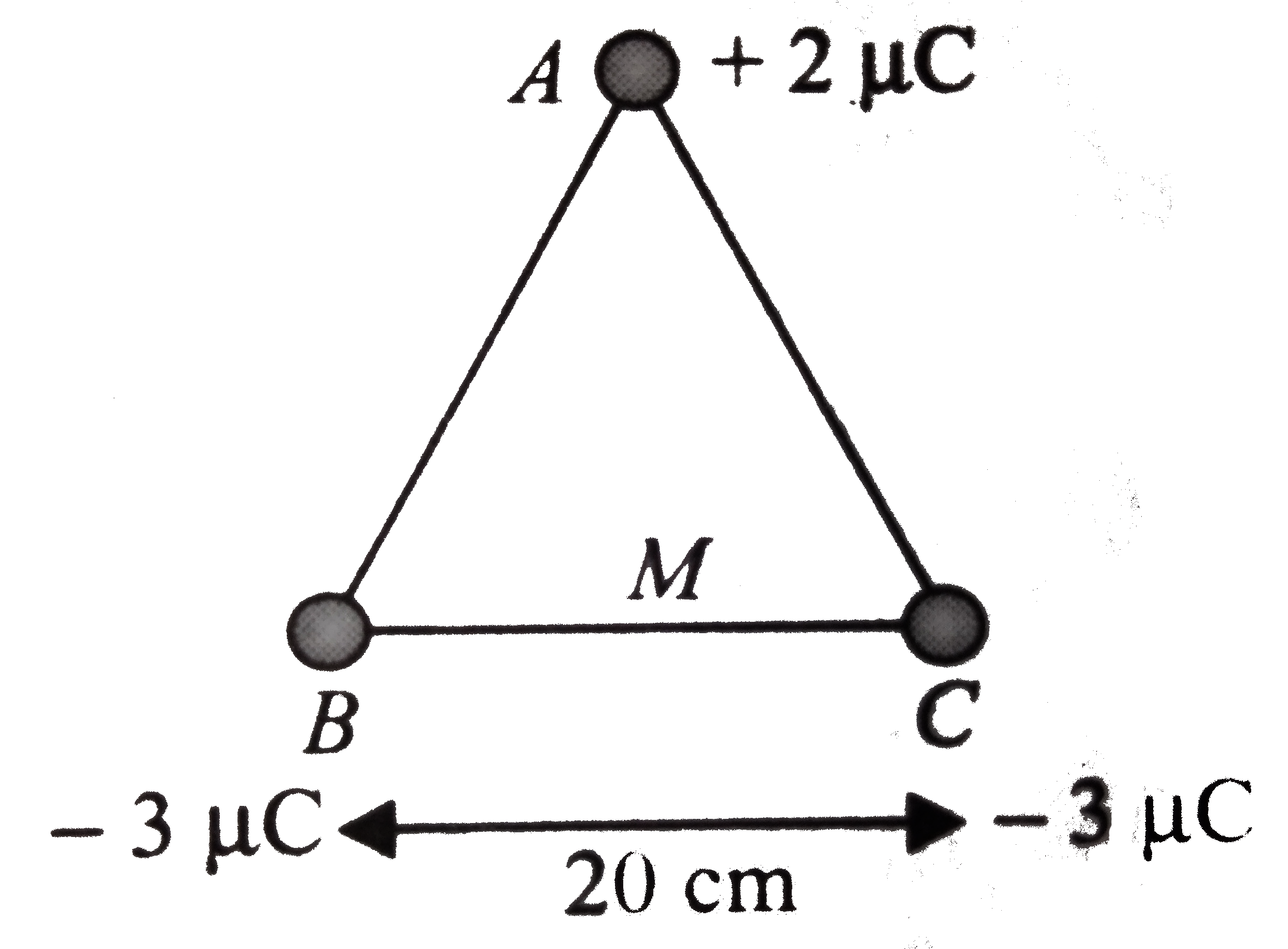
View SolutionA charges Q is placed at each of the two opposite corners of a square. A charge q is placed to each of the other two corners. If the resultant force on each charge q is zero, then
View SolutionEqual charges each of `20 muC` are placed at `x = 0, 2,4,8,16 cm` on X-axis. Find the force experienced by the charge at `x = 2cm`.
View SolutionCharges `q_(1) = 1.5 mC, q_(2) = 0.2 mC and q_(3) = -0.5 mC`, are placed at points A,B,C respectively as shown in Fig. If `r_(1) = 1.2m and r_(2) = 0.6m`, calculatae magnitude of resultant force on `q_(2)`.
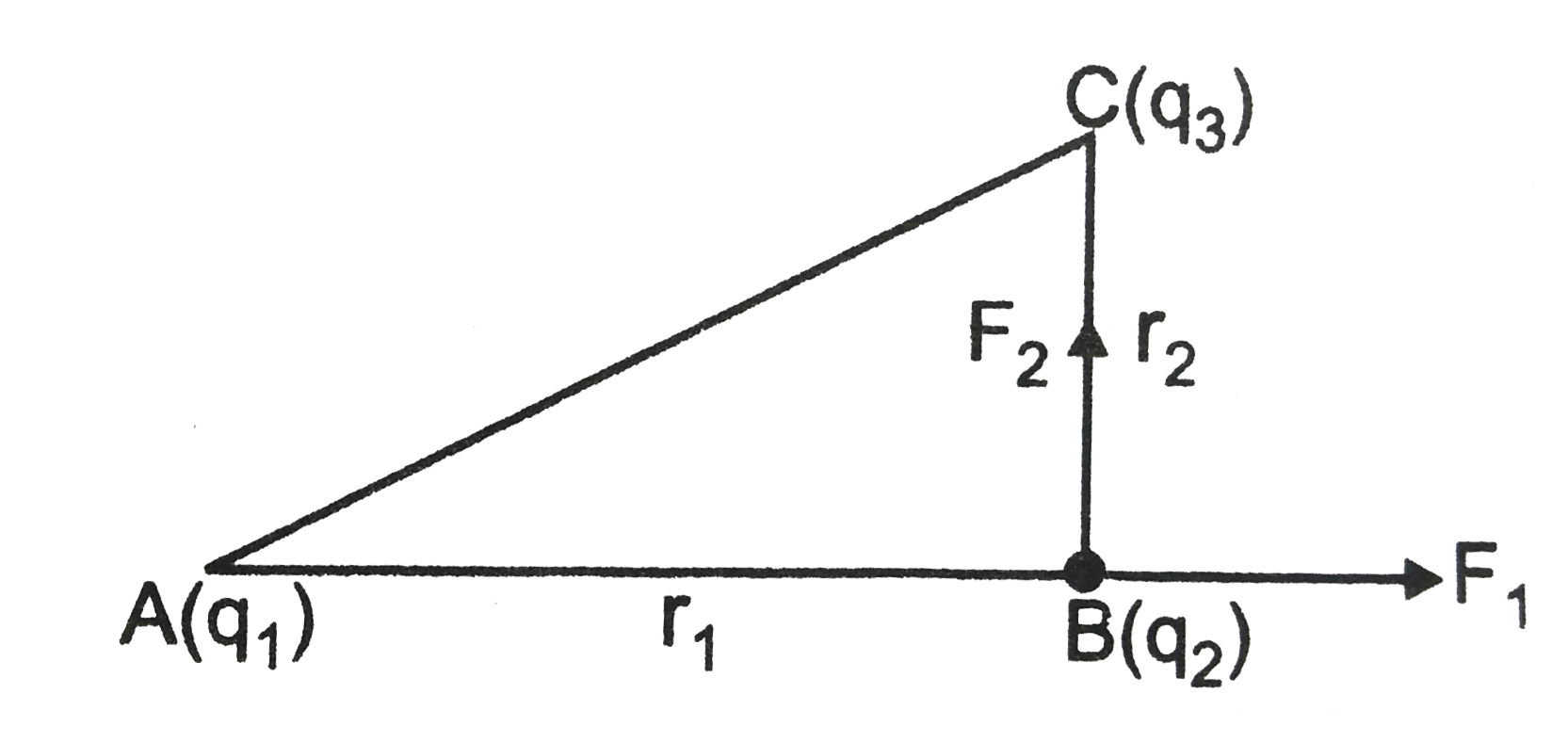
View SolutionTwo similarly and equally charged identical metal spheres A and B repel each other with a force of `2xx10^(-5)N`. A third identical uncharged sphere C is touched with A and then placed at the midpoint between A and B. Find the net electric force on C.
View SolutionLet us assume that charges on Earth and Sum are not neutralised and net charges are of equal magnitude and similar nature. What must be the charge on each so that coulomb force just cancels gravitational force ? This charge corresponds to how many free electrons ?
Mass of sun `= 2xx10^(30) kg`
Mass of earth `= 6xx10^(24) kg`
View SolutionIn a certain co-ordinate system, charge, `q_(1) = -2xx10^(-4) C` is at `x = 0, y = 0`, charge `q_(2) = 1xx10^(-3)C` is at `x = 10 m` and `y = 0` and charge `q_(3) = 1xx10^(-4)C` is at `x = 0, y = 5cm`, Find the magnitude of resultantant force on `q_(1)`
View SolutionTwo positive charges which are 0.1m apart repel each other with a force of 18N. If the sum of the charges be `9 muC`, calculate their separate values.
View SolutionIndenify X in the following nuclear reactions (in the first reaction, n represents a neutron) :
(a) `_(1)H^(1) + _(4)Be^(9) rarr X + _(o)n^(1)`,
(b) `_(6)C^(12) + _(1)H^(1) rarr X `,
(c ) `_(7)N^(15) + _(1)H^(1) rarr _(2)He^(4) + X`
View SolutionTwo equally charged particles, held `3.2xx10^(-3) m` apart, are released from rest. The initial accelerartion of the first particle is observed to be `7.0 m//s^(2)` and that of the secound to be `9.0 m//s^(2)`. If the mass of the first particle is `6.3xx10^(-7) kg`, what are (a) the mass of the secound particle adn (b) teh magnitude of the charge of each particle ?
View SolutionThe SI unit of electric field intensity is
View SolutionElectric field due to a single charge is
View SolutionElectric dipole moment is
View SolutionElectric field intensity (E) due to an electric dipole varies with distance (r) of the point from the center of dipole as :
View SolutionIf `E_(a)` be the electric field strength of a short dipole at a point on its axial line and `E_(e)` that on the equatorial line at the same distance, then
View SolutionElectric field due to an electric dipole is
View SolutionWhen an electric dipole is held at an angle in a uniform electric field, the net force F and torque `tau` on the dipole are
View SolutionPotential energy of an electric dipole held at an angle `theta` in a uniform electric is zero when `theta` =
View SolutionForce `vec(F)` acting on a test charge `q_(0)` in a uniform electric field `vec(E)` is
View SolutionElectric intensity is a …… quantity and its units are ………
View SolutionThe electric lines of force are ……….. as against magetic lines of force which are ……….. .
View SolutionNet charge on an electric dipole is ………….. .
View SolutionDipole moment is a …………. Quanity and its units are ……….. .
View SolutionField intensity due to a single charge varies inversely as ……….. of distance and field intensity due to an electric dipole varies inversely as ………. of distance of the point.
View SolutionIf `E_(a)` be the electric field strength of a short dipole at a point on its axial line and `E_(e)` that on the equatorial line at the same distance, then
View SolutionThe electric field due to an electric dipole is ……….. symmetric.
View SolutionThe torque acting on an electric dipole of moment p held at an angle `theta` with an electric field E is ………. .
View SolutionA small ball of paper has mass `9xx10^(-5) kg` and carries a charge of `5muC`. When it is held over another charged ball of paper at a distance of 2cm above it, the two balls stay in equilibrium. What is the charge on the second hall ?
View SolutionA water droplet of radius 1 micron in Milikan oil drop appartus in first held stationary under the influence of an electric field of intensity `5.1xx10^(4) NC^(-1)`. How many excess electrons does it carry ? Take `e = 1.6xx10^(-19) C, g = 9.8 ms^(-2)` and density of water of `= 10^(3) kg m^(-3)`.
View SolutionTwo point charges of `+16 muC and -9 mu C` are placed 8 cm apart in air. Determine the position of the point at which the resultant electric field is zero.
View SolutionA particle of mass m and charge q is thrown at a speed u against a uniform electric field E. How much distance will it travel before coming to momentary rest?
View SolutionA particle of mass m and charge q is released from rest in uniform electric field of intensity E. Calculate the kinetic energy it attains afect moving a distance x between the plates.
View SolutionA charged ball of mass `8.4xx10^(16) kg` is found to remain suspended in a uniform electric field of `2xx10^(4) Vm^(-1)`. Calculate the charge on the ball. Given `g = 10 m//s^(2)`
View SolutionTwo electric `+q and +4q` are placed at a distance 6a apart on a horizontal plane. Find the position of the point on the line joining the two charges where the electric field is zero.
View SolutionCalculate the magnitude of the electric field which can just balance a deuteron of mass `3.2xx10^(-27) kg`
View SolutionIn the electric field shown in figure, the electric field lines on the left have twice the separation as that between those on the right. If the magnitudes of the fields at point `A` is `40NC^(-1)`, calculate the force experienced by a proton placed at point `A`. Also find the magnitude of electric field at point `B`
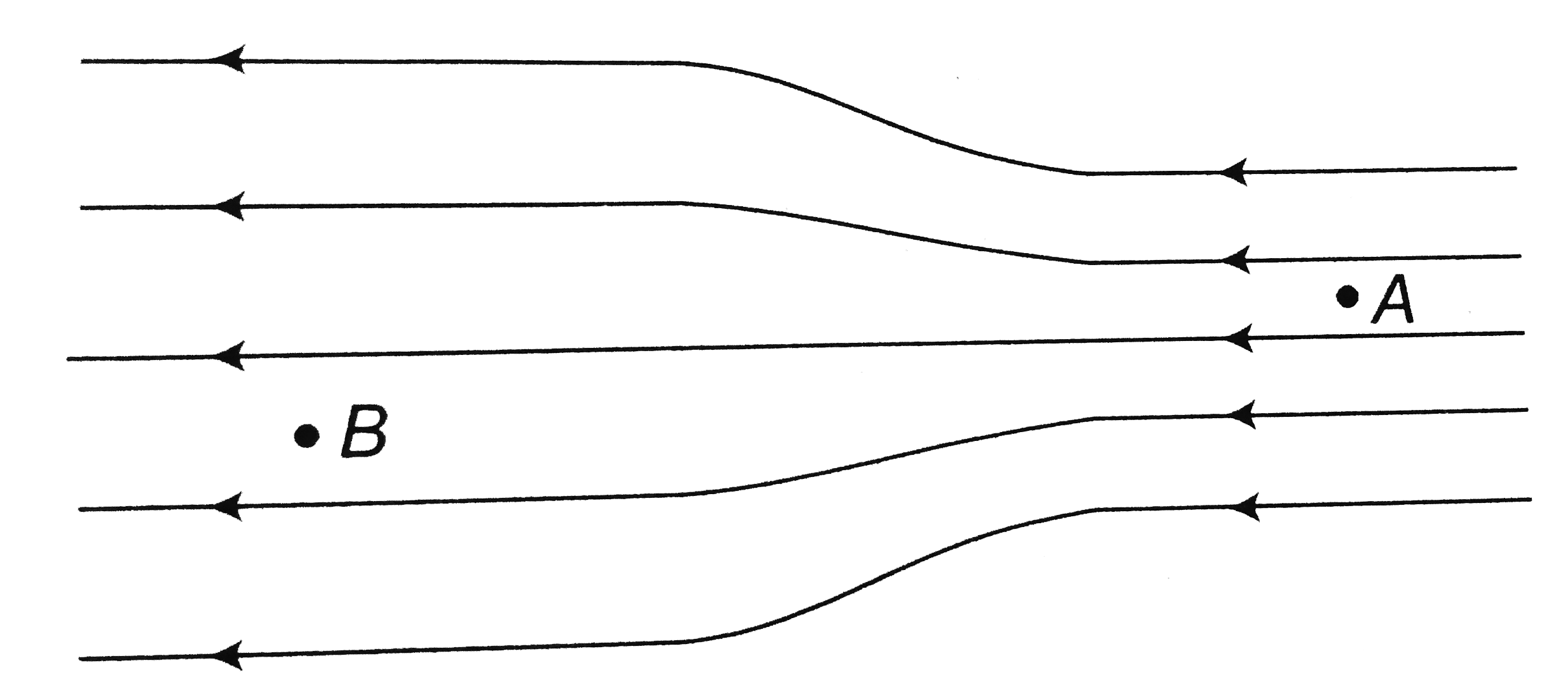
View SolutionEight identical point charges of q coulomb each are placed at the corners of a cube side 0.1m. Calculate electric field at the centre of the cube. Calculate the field at the center when one of the corner charges is removed.
View SolutionWhat are the magnitude and direction of the electric field at center of the square in Fig, if `q = 1.0xx10^(-8) C and a = 5.0 cm ?
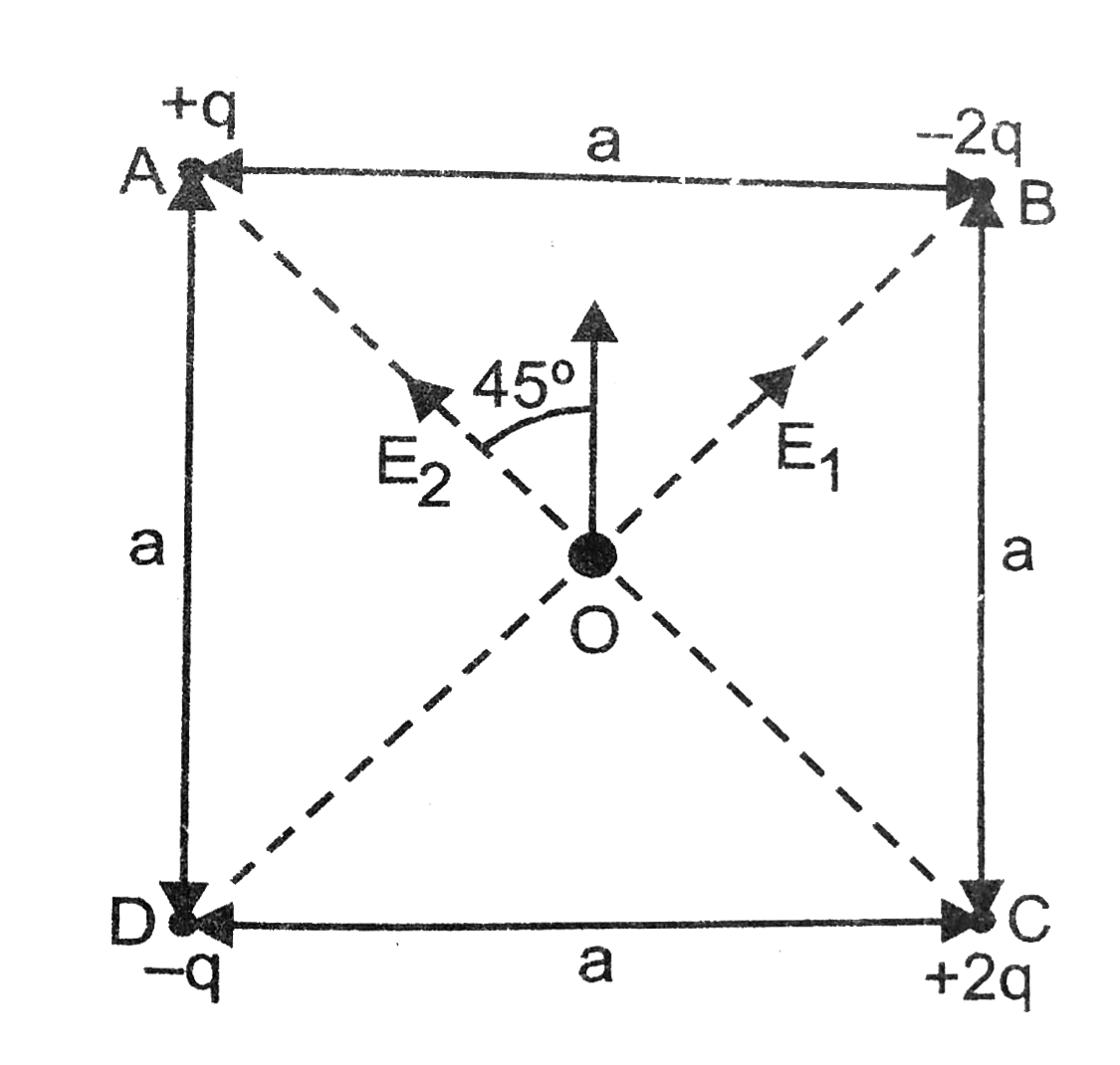
View SolutionA charge of `4xx10^(-9)C` is distributed uniformly over the circumference of a conducting ring of radius 0.3m. Calculate the field intensity at a point on the axis of the ring at 0.4m from its centre, and also at the centre.
View SolutionCalculate the magnitude of the force, due to an electric dipole of dipole moment `3.6xx10^(-29) C-m`, on an electric 25mm from the center of the dipole , along the dipole axis. Assume that this distance is large relative to the dipole's charge separation.
View SolutionCharge `q_(1) = +6.0n C` is on y-axis at `y = + 3cm` and charge `q_(2) = -6.0 n C` is on y-axis at `y = -3 cm`. Calculate force on a test charge `q_(0) = 2 n C` placed on X-axis at `x = 4cm`.
View SolutionABC is an equillatreal triangle of each side 5cm. Two charges of `+- (50)/(3) xx 10^(-3) mu C` are placed at A and B respectively. Calculate magnitude and direction of resultant intensity at C.
View Solution(i) Can two equpotential surfaces intersect each other ? Give reason.
(ii) Two charges `+ q and -q` are located at points A `(0, 0, -2) and B(0, 0, 2)` respectively. How much work will be done in moving a test charge from point P`(4, 0, 0) " to " (-5, 0,0)` ?
View SolutionTwo charges `+30 muC and -30 muC` are placed 1cm apart. Calculate electric field at a point on the axial line at a distance of 20cm from the centre of dipole.
View SolutionTwo charges `+0.2 mu mu C and -0.2 mu mu C` are placed `10^(-6) cm` apart. Calculate electric field at an axial point at a distance of 10 cm from their middle point.
View SolutionAn electric dipole of dipole moment `4xx10^(-5)` Cm is placed in a uniform electric field of `10^(-3) N//C` making an angle of `30^(@)` with the direction of the field. Determine the torque exerted by the electric field on the dipole.
View SolutionAn electric dipole is placed at an angle of `60^(@)` with an electric field of magnitude `4xx10^(5) NC^(-1)`, It experiencs a torque of `8 sqrt(3) Nm`. If length of dipole is 2 cm, determine the magnitude of either charge of the dipole.
View SolutionAn electric dipole of length 10cm having charges `+- 6xx10^(-3) C`, placed at `30^(@)` with respect to a uniform electric field experiences a torque of magnitude `6 sqrt(3) N-m`. Calculate (i) magnitude of electric field (ii) the potential energy of dipole.
View SolutionAn electric dipole of length 4 cm, when placed with its axis making an angle of `60^(@)` with a uniform electric field, experiences a torque of `4 sqrt(3) N m`. Calculate the
a. magnitude of the electric field, and
b. potential energy of the dipole, if the dipole has charges of `+- 8 n C`.
View SolutionAn electric dipole consists of two opposite charges of magnitude `q = 1xx10^(-6)C` separated by 2.0cm. The dipole is placed in an external field of `1xx10^(5) NC^(-1)`. What maximum torque does the field exert on the dipole ? How much work must an external agent do to rurn the dipole end for end, starting from position of aligment `(theta = 0^(@))` ?
View SolutionAn electric dipole consists of charges `+ 2e and -2e` separated by 0.78mm. It is an electric field of strength `3.4xx10^(6) N//C`. Calculate the magnitude of the torque on the dipole when the dipole moment is (a) parallel to (b) perpendicular to, and (c) antiparallel to the electric field.
View SolutionFour particles each having a charge q, are placed on the four vertices of a regular pentagon. The distance of each corner from the centre is a. Find the electric field at the centre of the pentagon.
View SolutionA copper ball of density `8.6 g//cc` amd 1 cm in diameter is immersed in oil of density `0.8 g//cc`. What is the charge on the ball, if it remains just suspended in oil in electric field of intensity `3600 V//m` acting in the upward direction ?
View SolutionTwo charges of `-4 muC and +4muC` are placed at the points `A (1,0,4) and B (2,-1,5)` location in an electric field `vec(E) = 0.20 hat(i) V//cm`. Calculate the torque acting on the dipole.
View SolutionAn infinite number of charges each equal to q, are placed along the X-axis at `x = 1, x = 2, x = 4, x = 8`,…….. and so on.
(i) find the electric field at a point `x = 0` due to this set up of charges.
(ii) What will be the elctric field if the above setup, the consecutive charges have opposite signs.
View SolutionA metal ball suspended from a long thread is held between the plates of a capacitor , as shown in Fig, How will the oscillations of this pendulum change, if the ball and the plates of two capacitor are charged ?
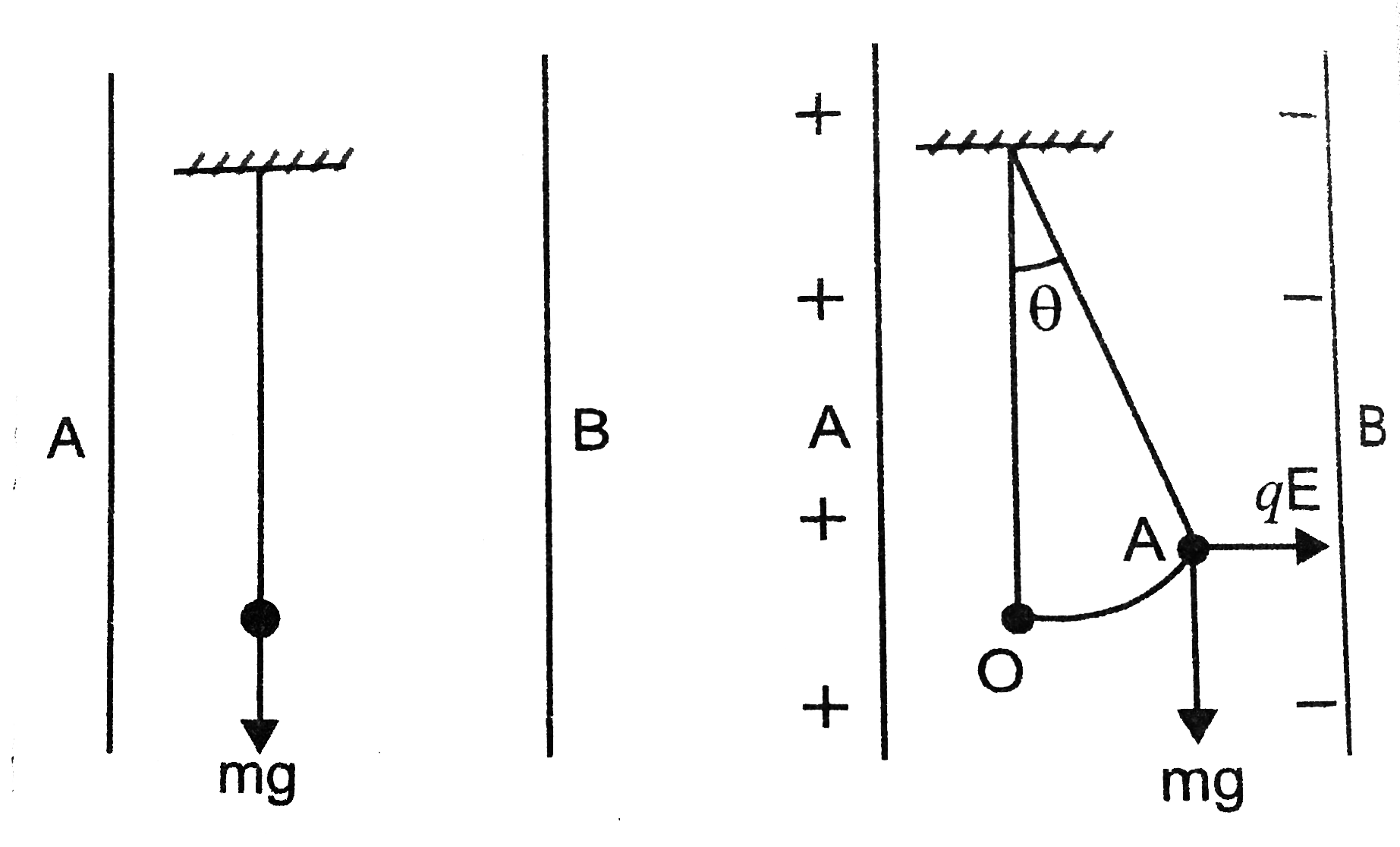
View SolutionElectrostatic potentail V at point, distant r from a charge q varies as
View SolutionWork done in carrying an electron from A to B lying on an equipotential surface of one volt potential is
View SolutionThe correct relation between electric intensity E and electric potential V is
View SolutionI G ev = x eV, where x is
View SolutionThe dimensional formula of electric flux is
View SolutionA closed surface is vacumm encloses charges `-q and +3q`. Another charge `-2q` lies outside the surface. Total electric flux over the surface is
View SolutionThe number of electric lines of forces rediating from a closed surface in vacumm is `1.13xx10^(11)`. The charge enclosed by the surface is
View SolutionA charge of `10 mu C` lies at the centre of a square. Work done in carrying a charge of `2 muC` from one corner of square to the diagonally opposite corner is
View SolutionA Uniform electric field of `10NC ^(-1)` exists in the vertically downward direction. Find the increase in the electric potential as one goes up through a height of 50cm.
View SolutionElectric potential V and electric flux `phi` are
View SolutionWork done by an electrostatic field in moving a given charge from one point to another …… upon the chosen.
View SolutionPotential difference between any two points B and A in an electrostatic field is the amount of work done in carrying ………… from …………. to ………………….. .
View SolutionElectric potential is a …………….. Quantity and its units are …………… .
View SolutionElectrostatic forces are ……… forces.
View SolutionElectric potential on dipole axis varies inversely as ……….. Of distance of point from the center of electric dipole.
View SolutionElectric potential at any point in equatorial plane of a dipole is ………. .
View Solution
Exercise questions and complete solutions for chapter ELECTROSTATICS of PRADEEP PHYSICS (HINGLISH) of Class 12
All Exercises from PRADEEP Class 12 PHYSICS ELECTROSTATICS
- ADDITIONAL QUESTIONS
- ADVANCED PROBLEMS FOR COMPETITIONS
- ASSERTION-REASON TYPE QUESTIONS
- COMPREHENSION
- CONCEPTUAL PROBLEMS
- CURIOSITY QUESTIONS
- Exercise
- FILL IN THE BLANKS
- LONG ANSWER QUESTIONS
- MULTIPLE CHOICE QUESTIONS
- NCERT QUESTIONS
- PROBLEMS FOR PRACTICE
- SHORT ANSWER QUESTIONS
- TYPICAL EXAMPLES
- VALUE BASED QUESTIONS
- VERY SHORT ANSWER QUESTIONS